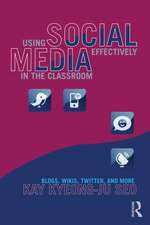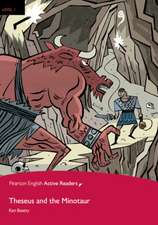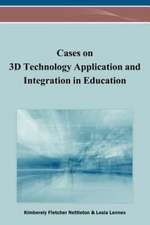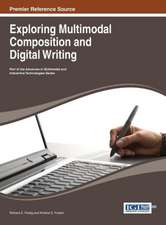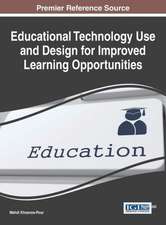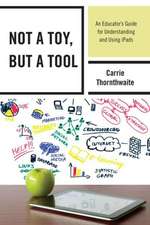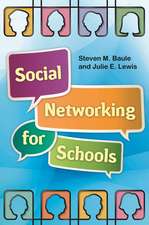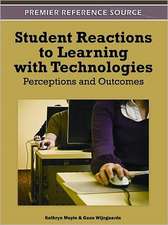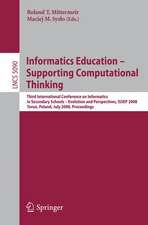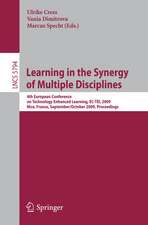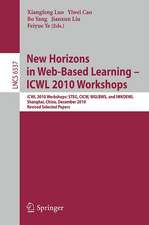Teaching & Researching: Computer-Assisted Language Learning: Applied Linguistics in Action
Autor Ken Beattyen Limba Engleză Hardback – 26 noi 2015
Computers play a crucial and rapidly evolving role in education, particularly in the area of language learning. Far from being a tool mimicking a textbook or teacher, Computer-Assisted Language Learning (CALL) has the power to transform language learning through the pioneering application of innovative research and practices.
Technological innovation creates opportunities to revisit old ideas, conduct new research and challenge established beliefs, meaning that the field is constantly undergoing change. This fully revised second edition brings teachers and researchers up-to-date by offering:
- A comprehensive overview of CALL and current research issues
- Step-by-step instructions on conducting research projects in CALL
- Extensive resources in the form of contacts, websites and free software references
- A glossary of terms related to CALL
Ken Beatty has taught at colleges and universities in Canada, Asia and the Middle East. His publications include more than 100 textbooks for learning English as a Second Language, as well as various websites, CD-ROMs and educational videos.
| Toate formatele și edițiile | Preț | Express |
|---|---|---|
| Paperback (1) | 356.44 lei 6-8 săpt. | |
| Taylor & Francis – 10 iun 2010 | 356.44 lei 6-8 săpt. | |
| Hardback (1) | 1000.27 lei 6-8 săpt. | |
| Taylor & Francis – 26 noi 2015 | 1000.27 lei 6-8 săpt. |
Preț: 1000.27 lei
Preț vechi: 1219.84 lei
-18% Nou
Puncte Express: 1500
Preț estimativ în valută:
191.40€ • 199.84$ • 158.41£
191.40€ • 199.84$ • 158.41£
Carte tipărită la comandă
Livrare economică 04-18 aprilie
Preluare comenzi: 021 569.72.76
Specificații
ISBN-13: 9781138131842
ISBN-10: 1138131849
Pagini: 304
Dimensiuni: 156 x 234 x 18 mm
Greutate: 0.45 kg
Ediția:2nd edition
Editura: Taylor & Francis
Colecția Routledge
Seria Applied Linguistics in Action
Locul publicării:Oxford, United Kingdom
ISBN-10: 1138131849
Pagini: 304
Dimensiuni: 156 x 234 x 18 mm
Greutate: 0.45 kg
Ediția:2nd edition
Editura: Taylor & Francis
Colecția Routledge
Seria Applied Linguistics in Action
Locul publicării:Oxford, United Kingdom
Cuprins
Contents
General Editors’ Preface
Acknowledgements
Introduction
Section I Key concepts
1 The emergence of CALL
1.1 A broad discipline
1.2 Technology driving CALL
1.3 The changing focus of research in CALL
Summary
2 A brief history of CALL
2.1 CALL in the 1950s and 1960s
2.2 Simulations
2.3 CALL in the 1970s and 1980s
2.4 CALL in the 1990s
2.5 CALL in the 21st Century
Summary
3 Hypertext, hypermedia and multimedia
3.1 Hypertext
3.2 Hypermedia
3.3 Multimedia
3.4 Antecedents of multimedia
3.5 Science fiction and CALL
3.6 The printed book and CALL
3.7 Applications to general learning
3.8 Applications of multimedia to language learning
Summary
4 Eight CALL applications
4.1 Word processing
4.2 Games
4.3 Literature
4.4 Corpus linguistics
4.5 Computer-mediated communication
4.6 WWW resources
4.7 Adapting other materials for CALL
4.8 Personal Digital Assistants (PDAs) and Mobile Telephones
Summary
Section II The place of CALL in research and teaching
5 Second-language Acquisition and models of instruction
5.1 Concepts in SLA, behaviourism and constructivism
5.2 Comprehensible input and output
5.3 Behaviourist models of instruction
5.4 Constructivism
Summary
6 Collaboration and negotiation of meaning
6.1 The place of collaboration in CALL
6.2 Structuring collaboration
6.3 Differences between collaboration and other terms
6.4 The range of collaboration and CALL
6.5 Collaboration at the computer
6.6 Benefits of collaborative learning at the computer
6.7 Collaboration, CALL and SLA
6.8 Collaboration at the computer as evidenced by discourse
6.9 Challenges to collaboration
6.10 Challenges to collaboration in a CALL context
6.11 Discourse that evidences challenges to collaboration
Summary
7 Defining a model of CALL
7.1 Defining a model
7.2 The need for a CALL model
7.3 A model of current non-CALL language learning
7.4 Dunkin and Biddle’s model in a CALL context
7.5 Various views of CALL
7.6 Teacher and pupil classroom behavior: activities used in CALL
7.7 A virtual classroom
7.8 Aspects of a CALL model
Summary
8 Theoretical and pedagogical concerns
8.1 Concerns for software development
8.2 Pedagogical concerns for classroom practice
8.3 &uating software
8.4 Learning and working styles
8.5 Evolving technology
8.6 Commercial software
8.7 Making better use of existing materials
8.8 Copyright and plagiarism
8.9 Viruses
8.10 Safety online
8.11 Technological have-nots
Summary
Section III Researching CALL
9 Current research interests
9.1 A new field: reporting CALL research
9.2 Approaches to research in CALL
9.3 The computer as a tool of research
9.4 The role of commercial publishers
9.5 Reviewing current studies: a survey
9.6 Conducting research
9.7 Action research
Summary
10 Research
10.1 Research context 1: The literature review
10.2 Research context 2: A pilot study
10.3 Research context 3: Corpus linguistics
10.4 Research context 4: Error analysis
10.5 Research context 5: The experiment
10.6 Research context 6: A case study
10.7 Research context 7: The survey
10.8 Research context 8: The ethnographic approach
Conclusion
Section IV Resources
Glossary of key terms
References
Index
General Editors’ Preface
Acknowledgements
Introduction
Section I Key concepts
1 The emergence of CALL
1.1 A broad discipline
1.2 Technology driving CALL
1.3 The changing focus of research in CALL
Summary
2 A brief history of CALL
2.1 CALL in the 1950s and 1960s
2.2 Simulations
2.3 CALL in the 1970s and 1980s
2.4 CALL in the 1990s
2.5 CALL in the 21st Century
Summary
3 Hypertext, hypermedia and multimedia
3.1 Hypertext
3.2 Hypermedia
3.3 Multimedia
3.4 Antecedents of multimedia
3.5 Science fiction and CALL
3.6 The printed book and CALL
3.7 Applications to general learning
3.8 Applications of multimedia to language learning
Summary
4 Eight CALL applications
4.1 Word processing
4.2 Games
4.3 Literature
4.4 Corpus linguistics
4.5 Computer-mediated communication
4.6 WWW resources
4.7 Adapting other materials for CALL
4.8 Personal Digital Assistants (PDAs) and Mobile Telephones
Summary
Section II The place of CALL in research and teaching
5 Second-language Acquisition and models of instruction
5.1 Concepts in SLA, behaviourism and constructivism
5.2 Comprehensible input and output
5.3 Behaviourist models of instruction
5.4 Constructivism
Summary
6 Collaboration and negotiation of meaning
6.1 The place of collaboration in CALL
6.2 Structuring collaboration
6.3 Differences between collaboration and other terms
6.4 The range of collaboration and CALL
6.5 Collaboration at the computer
6.6 Benefits of collaborative learning at the computer
6.7 Collaboration, CALL and SLA
6.8 Collaboration at the computer as evidenced by discourse
6.9 Challenges to collaboration
6.10 Challenges to collaboration in a CALL context
6.11 Discourse that evidences challenges to collaboration
Summary
7 Defining a model of CALL
7.1 Defining a model
7.2 The need for a CALL model
7.3 A model of current non-CALL language learning
7.4 Dunkin and Biddle’s model in a CALL context
7.5 Various views of CALL
7.6 Teacher and pupil classroom behavior: activities used in CALL
7.7 A virtual classroom
7.8 Aspects of a CALL model
Summary
8 Theoretical and pedagogical concerns
8.1 Concerns for software development
8.2 Pedagogical concerns for classroom practice
8.3 &uating software
8.4 Learning and working styles
8.5 Evolving technology
8.6 Commercial software
8.7 Making better use of existing materials
8.8 Copyright and plagiarism
8.9 Viruses
8.10 Safety online
8.11 Technological have-nots
Summary
Section III Researching CALL
9 Current research interests
9.1 A new field: reporting CALL research
9.2 Approaches to research in CALL
9.3 The computer as a tool of research
9.4 The role of commercial publishers
9.5 Reviewing current studies: a survey
9.6 Conducting research
9.7 Action research
Summary
10 Research
10.1 Research context 1: The literature review
10.2 Research context 2: A pilot study
10.3 Research context 3: Corpus linguistics
10.4 Research context 4: Error analysis
10.5 Research context 5: The experiment
10.6 Research context 6: A case study
10.7 Research context 7: The survey
10.8 Research context 8: The ethnographic approach
Conclusion
Section IV Resources
Glossary of key terms
References
Index
Notă biografică
Ken Beatty has taught at colleges and universities in Canada, Asia and the Middle East. His publications include more than 100 textbooks for learning English as a Second Language, as well as various websites, CD-ROMs and educational videos.
Descriere
Computers increasingly play an important role in education, particularly language learning. But Computer-assisted Language Learning (CALL) is constantly undergoing change because of technological advances that create opportunities to revisit old ideas, to conduct new research and to challenge established beliefs about the ways in which teaching and learning can be carried out both with and without a human teacher. This book offers teachers and researchers a better understanding of CALL through:
- A comprehensive overview of CALL, fully updated to take into account the Web 2.0 revolution
- Step-by-step instructions on conducting research projects in CALL
- Extensive resources in the form of contacts, websites and free software references
- A glossary of terms related to CALL














